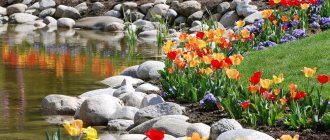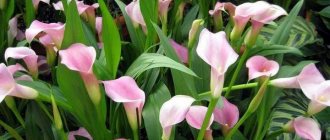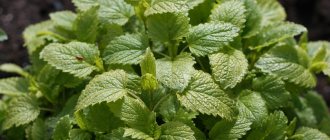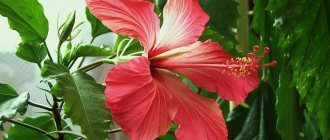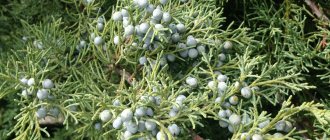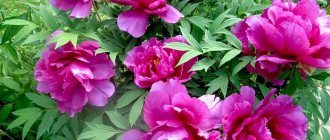Botanical description
Japanese camellia belongs to the Tea family, genus Camelliaceae . Under natural conditions, this is a large shrub or even a tree: representatives are known that have outgrown the 10-meter height mark.
In indoor conditions, camellia will not reach such heights and will grow to a maximum of 2 meters. But even such a bush requires a lot of space to accommodate.
Externally, camellia resembles a ball, which adds charm to the bush. The leaf blades are medium sized, soft and glossy, but it is the camellia blooms that are of most interest.
It occurs in winter and usually begins in November and ends in April - May. The color of the inflorescences is varied: red, white, pink and variations of their shades .
Varieties of Japanese camellia with photos
Thanks to the work of breeders, flower lovers have access to various variations of japonica.
Double white
Refers to double varieties with a perfectly white color and almost perfect radial symmetry. The flowers of the variety are large, spherical, with a light terry edging along the very edge of the petal.
The leaf blades are slightly elongated, with a glossy sheen on both sides of the leaf.
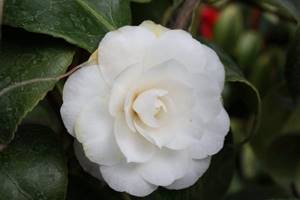
Giulio Nucci
The color of the petals is a beautiful crimson color, and their shape is significantly different. The petals forming the outer circle are larger and more elongated than the inner ones.
The petals located in the inner part of the inflorescence are smaller and thinner, which is why they often curl like curls and are arranged very densely. In the center are bright yellow stamens.
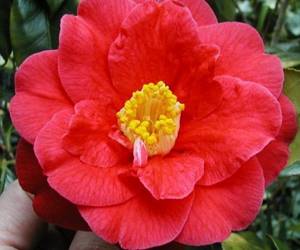
Lavinia maggi
An interesting variety with large corollas, painted pale pink with crimson veins. But there are specimens with completely pink inflorescences.
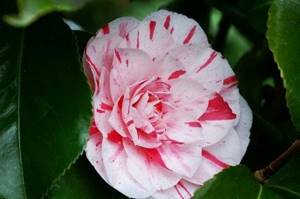
Princess Baciocchi
The inflorescences are crimson in color, slightly double, with light white stripes. The petals are round, slightly pointed. It begins to bloom in February, the end of flowering occurs in May.
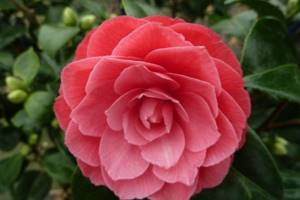
Margaret Davis
Terry variety, painted in two colors. The outer edge of the petals is pink or red, the width of the border reaches 4 mm. Inflorescence petals:
- the lower ones are large, round, arranged in several rows;
- the upper ones are much smaller and thinner than the outer ones, they are located very densely, their color is usually creamy white, uniform.
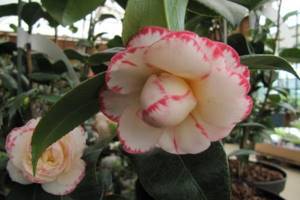
Brushfield's yellow
The flowers of this camellia are beautiful cream-colored, double, with bright light yellow petals in the center.
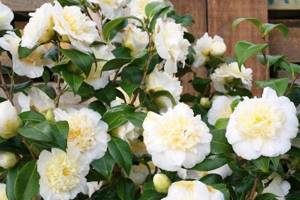
Lady Campbell
The inflorescences look like peony corollas, only double. They are painted pure red, but sometimes a thin white stripe is visible in the central part of the petal.

Linda Rosazza
The variety was bred by Italian breeders relatively recently - in the second half of the twentieth century. The inflorescences are large, about 10 cm, with ideal radial symmetry of the petals.
The color is snow-white. There may be a thin terry border along the edge of the petals.
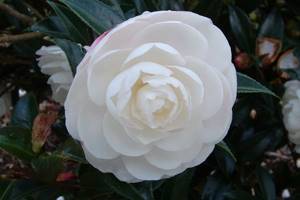
Pink perfection
Camellia lovers place this variety on the podium, and for good reason. It is rightfully considered one of the most beautiful among camellias.
The color of the petals is soft pink, they are all the same size, their edges are slightly bent towards the inside of the flower. Flowers have high decorative qualities.

Dazaire
Its inflorescences are very similar to rose flowers, but larger (diameter can reach up to 12 cm). Belongs to semi-double varieties. The petals are painted in two colors: the inner part is white and the outer part is pink. The color change is very smooth.
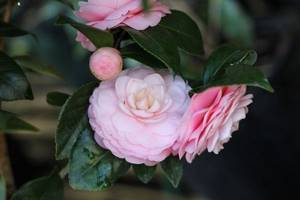
Ashani
It is distinguished by a small number of equally sized smooth petals. In the center of the inflorescence there are yellow stamens arranged in a circle.
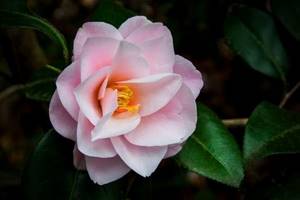
Vittorio Emanuel
Semi-double petals are formed into an inflorescence of original outlines: its petals are curved in the opposite direction. Its color is also interesting: the main color is white, but due to the intense pink spots and stripes a unique pattern appears.

Lady Vansittar
Low-double variety with double color (pink and red). Moreover, each color has its own place on the petal. The petals are equal in size and of the same shape.
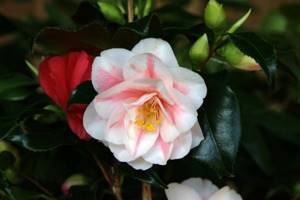
Tricolor
The inflorescence size is medium (does not exceed 8 cm), the color is predominantly white with different-sized stripes of red and pink colors. Yellow stamens are located in the center.
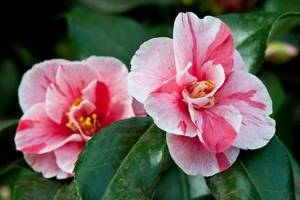
Chanders Red
Japanese red camellia has a flower size of about 10 cm. The petals are the same size with a pointed tip and the same shape. The corolla is deep red.
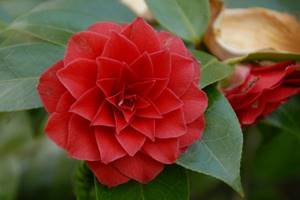
Camellia japonica "Blood of China"
Peony-shaped inflorescences of a beautiful red hue, slightly double. The stamens located in the center are golden yellow.

Camellia domestica
At home, a Japanese camellia bush is always more compact than one grown in a garden or greenhouse.
Thanks to the work of breeders, there are many color and size options. Homemade camellia blooms differently depending on the varietal characteristics, but more often the appearance of flower stalks occurs in the winter .

Watering, fertilizing and other care for Japanese camellia
Care for camellia japonica consists of:
- from careful watering, the intensity and frequency of which depends on the season and condition of the plant;
- from fertilizing in the spring-summer period;
- from pruning carried out in the second half of autumn and allowing the crop to maintain a compact crown at home;
- from transplanting an overgrown bush.
While the green pet is blooming, it requires increased attention. Water the plant very carefully, since in cold weather water from the surface of the soil evaporates slowly, and determining the soil moisture at the roots is not always easy.
If the root system remains in soil saturated with moisture for a long time, the appearance of rot and other infections cannot be avoided.
A little lemon juice or vinegar is added to the settled irrigation water, which improves the health of the Japanese camellia and, as in the photo, gives brightness to the flowers.
At the bud formation stage, the shrub should receive regular support in the form of a complex fertilizer for azaleas. Fertilizing is carried out every 10–14 days, and in the summer you can fertilize the plant only once a month.
Home care
Camellia is capricious. It will take a lot of effort to grow it. Perhaps it will be difficult for a novice gardener to care for the wayward beauty .
But if you wish, with a little patience, you can achieve active growth and development of camellia.
Conditions
Camellia requires enough space, then it feels comfortable. In addition, the length of daylight must be observed : it must be at least 12 hours.
If there is not enough natural light, the beauty needs to be additionally illuminated with phytolamps. Important! Lack of light can lead not only to a lack of buds, but also to loss of foliage.
When does Japanese camellia bloom (indoors)
The flowering period of camellia does not coincide with the flowering of most indoor plants and occurs in the winter months. Usually by the end of spring the buds fall off.
View this post on Instagram
Posted by Olya (@dori_ribka) April 17, 2021 at 12:12 PDT
Temperature
Particular attention should be paid to organizing the temperature regime, since in summer and in winter the temperature of keeping the beauty is very different .
From the end of spring until the start of buds, it is recommended to maintain the temperature between 20 and 25 °C. However, at the beginning of budding, the temperature must be gradually reduced to 18...20 ° C and maintained at this level for about 30 days until the buds are formed.
During flowering, which for camellias occurs in the winter months, the temperature is also reduced and kept within 8...12 °C.
An increase in temperature even by 1 degree above 12 °C can lead to the shedding of not only unopened buds, but also open inflorescences, and even the loss of part of the foliage.
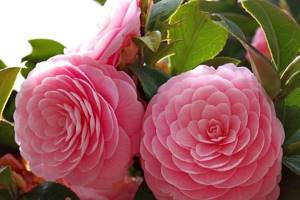
The soil
The main criteria for choosing a substrate are not its poverty or enrichment in minerals, but its friability and acidity . It is optimal to choose a substrate that is as similar as possible to the soils in places where camellias naturally grow.
Proportions for making your own soil:
- 2 parts leaf soil;
- 2 parts of coniferous land;
- 2 parts peat;
- 2 parts perlite;
- 2 parts sand.
The soil should be sufficiently loose and breathable. There is no need to further disinfect it.
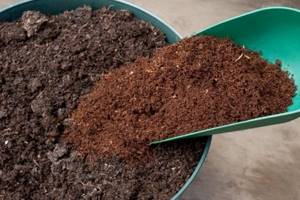
Pot
There are no special requirements for the pot. For a young plant, you should not immediately select a large container : a medium-sized pot with a drainage hole is suitable. The camellia is transferred to a tub or large pot when it has grown stronger and larger.
Important! At least a quarter of the pot’s volume should be occupied by drainage. The accumulation of moisture in the root part of camellia is contraindicated.
Irrigation mode and air humidity
Camellia loves moisture, but the regime of water procedures is significantly influenced by seasonality. Water as the top layer of soil dries:
- in summer 2–3 times a week;
- in winter once every 4–6 days.
The Japanese beauty does not tolerate dry air well. However, you need to spray the capricious plant extremely carefully, because not a drop should get on the buds.
To play it safe, many gardeners place a container filled with water or an automatic humidifier next to the camellia to humidify the air.
View this post on Instagram
Posted by Olga Gusarova (@gussarovahelga) March 22, 2021 at 7:40 PDT
Pruning
Camellia often reacts to pruning by dropping flowers and buds. But formative and sanitary pruning should be carried out regularly , preferably in the spring after flowering has ended.
Excessively elongated shoots and dried branches are shortened.
Features of seasonal care
Unlike other indoor crops, camellia blooms during the dormant period, in winter, and vegetative processes are activated in the spring. During this period, it is important to regularly water the plant and apply fertilizing on time. In winter, the flower is comfortable in cool conditions. If kept in a warm room, the buds may fall off and the camellia will not bloom. The light should be diffuse throughout the year. Daylight hours should last 10-12 hours. In winter there is not enough of it, so the plant is provided with additional lighting. Humidity should be high in any season.
Reproduction
Camellia is propagated by vegetative methods; especially stubborn ones germinate seeds .
Cuttings
Cuttings are prepared in August:
- Young shoots that have not yet become woody are selected.
- Directing a well-sharpened sterile blade at an acute angle, the stalk is cut so that its length is at least 8 cm.
- All leaves are removed except for the top couple.
- To stimulate root formation, you can use the “Kornevin” product.
- For rooting, a sand-peat mixture is used. The cuttings are not buried deeply - 3 cm is enough.
- The planted cuttings are watered and covered with a bag, forming a mini-greenhouse, and placed in a warm, well-lit place.
- The greenhouse is ventilated daily.
- After about 50–60 days, the plant can be transplanted into an individual pot.
Seeds
Propagation by seeds is rarely practiced among amateur gardeners, since the seeds quickly lose their viability .
What you need to do to get a sprout from camellia seeds:
- Select small boxes with sand and peat substrate.
- Seeds are planted no deeper than 3 cm according to the following scheme: 5 cm distance between rows, 6 cm between seeds;
- Water the soil generously and cover the container with glass or cling film.
- The glass is removed daily to ventilate the soil.
- Withstands temperatures from 20 to 25 °C.
- Water only with a spray bottle.
- After germination, the glass can be removed.
- After the sprout produces two true leaves, it can be transplanted into its own pot.
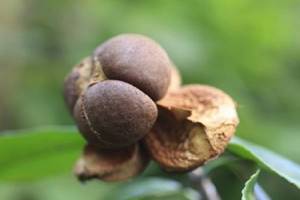
By layering
Another popular method of vegetative propagation is air layering .
Formation technique:
- A young, strong shoot with soft bark is selected from the plant.
- Using a sharp sterile blade, cut it at the base so that 2–3 mm of living tissue is connected to the main stem.
- All leaves are cut from the stem, except one - the very first from the growth bud.
- The stem is cut about 1 cm deep into the shoot to form roots.
- The incision site is wrapped in damp sphagnum moss and cling film on top - this will start the root formation process.
- When the aerial roots reach a length of 1.5–2 cm, the cuttings can be carefully separated from the mother trunk and planted in a permanent place.

Possible difficulties during cultivation
If the conditions for maintaining the camellia are violated, diseases may begin to develop or the plant may be attacked by parasites.
Due to too frequent watering and improper organization of drainage, the bush is affected by root rot . Its signs:
- wilting of buds;
- unpleasant smell from the soil in the pot.
To save your pet, transplant it into a new pot, after first removing the damaged roots and completely removing the affected soil.
The appearance of parasites on camellia may be indicated by dark tubercles on the back of the leaf blades (scale insects) or a whitish coating (mealybug).
In such cases, the plant is treated with insecticides according to the instructions.
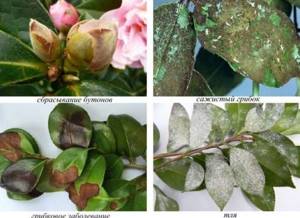
Camellia flower meaning
The plant's homeland is Southeast Asia. Flowers are very popular in China and Japan, which is reflected in the paintings of these countries. The name of the flower is derived from the name of the Jesuit missionary Georg Joseph Kamel, who lived in the 17th century. The man was impressed by the flowering of “roses without thorns”, and he brought this plant to Europe.
In Japanese, camellia is called "tsubaki". An entire province on the island of Kyushu was named after the plant. Then the provincial governor defeated the bandit leader with a club made from camellia wood. This significant event was reflected in written sources and became the first historical mention of the flower.
Camellia symbolism
Flowers have attracted people's attention since ancient times. Throughout the existence of the camellia, the flower has been perceived controversially. For a long time, the plant was considered a truly “samurai flower”; it was used as decoration only by representatives of this class. And in the 14th century, a belief arose that a samurai who touched a flower would be beheaded. This opinion arose because tsubaki buds fall to the ground without losing their petals.
According to another belief, the camellia was the personification of the sun goddess Amaterasu, from whom the line of emperors of Japan descends. And when Christianity appeared in the country, the flower became a sign of Jesus Christ. Representatives of this religion were forbidden to wear a cross.
Nowadays, camellias symbolize resilience and longevity due to the flower's ability to withstand temperatures of -25 degrees.
Planting camellias in open ground
To plant camellia in the garden, select a suitable seedling. The place should be with diffused light so that direct sunlight does not burn the foliage . Protect the planting from drafts and moisture accumulation in the root zone.
Preparation for landing:
- Dig a hole; its size should be 2 times the size of the camellia root system.
- Place a layer of pebbles on the bottom to drain excess moisture.
- Remove the seedling from the pot along with the earthen lump and cover it with the prepared substrate.
- Water thoroughly.
Camellia is a beautiful plant. If you follow all the recommendations, the capricious beauty will delight you with its blooms for many years.
Diseases and pests, control methods
Camellia is rarely affected by pests and diseases. But often inexperienced flower growers make mistakes in care, which affects the health of the flower. Due to excessive soil moisture and cold storage, root rot may appear. If it is detected, you need to transplant the flower into fresh, loose soil as quickly as possible. Reducing watering is unlikely to help if you leave the camellia in an old pot. Due to excessive air humidity, phyllosticosis may develop. To save the flower, it must be treated with copper sulfate. Remove damaged parts of the plant.
Camellia pests:
- aphid;
- spider mite;
- scale insect
If they are detected, you can treat the plant with a soap solution or lubricate it with a swab dipped in kerosene. In case of serious damage, it is better to resort to the help of special chemicals:
- Aktellik;
- Fufanon;
- Aktara;
- Fitoverm;
- Spark.
Source: https://roomflower.ru/


